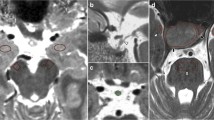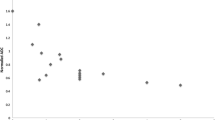Abstract
Purpose
To classify pituitary macroadenomas according to the Trouillas’ grading system; to compare this grading system with T2 values of volumetric signal intensity to determine T2 values able to predict the final grade.
Methods
A total of 106 patients with macroadenomas were grouped according to the grading system score combining proliferation and invasiveness criteria of Trouillas’ classification. Normalized volumetric signal intensity values were extracted from coronal T2-weighted images (nT2mean, nT2Max, nT2min) and were compared with the final grading score system.
Results
Thirty-three patients were in grade 1a (non-invasive, non-proliferative tumors), 17 patients in grade 1b (non-invasive, proliferative tumors), 36 patients in grade 2a (invasive, non-proliferative tumors), and 20 patients in grade 2b (invasive, proliferative tumors). No patient was in grade 3 (metastatic tumors). nT2Max and nT2min were the best quantitative values to discriminate invasive from non-invasive grades; in invasive grades, nT2Max intensity values were higher, and nT2min intensity values were lower than in non-invasive grades.
Receiver operating characteristic analysis of nT2 values showed that nT2min values had a better diagnostic performance than nT2Max values because they allowed differentiating with a moderate accuracy invasive tumors (2a or 2b grades) from both non-invasive proliferative tumors (1b) and non-invasive-non proliferative tumors (1a) (2a vs 1b: AUCnT2min = 0.78, 2b vs 1b: AUCnT2min = 0.72, 2a vs 1a: AUCnT2min = 0.72, 2b vs 1a AUCnT2min = 0.69).
Conclusion
Volumetric nT2Max and nT2min values of MRI might be practical and non-invasive markers for assessing tumor invasiveness although nT2 min signal intensity values have more effects in discriminating tumor’s invasive behavior.





Similar content being viewed by others
References
Chen Y, Wang CD, Su ZP et al (2012) Natural history of postoperative nonfunctioning pituitary adenomas: a systematic review and meta-analysis. Neuroendocrinology 96:333–342. https://doi.org/10.1159/000339823
Mercado M, Melgar V, Salame L, Cuenca D (2017) Clinically non-functioning pituitary adenomas: pathogenic, diagnostic and therapeutic aspects. Endocrinol Diabetes Nutr 64:384–395. https://doi.org/10.1016/j.endinu.2017.05.009
Fernández-Balsells MM, Murad MH, Barwise A et al (2011) Natural history of nonfunctioning pituitary adenomas and incidentalomas: a systematic review and metaanalysis. J Clin Endocrinol Metab 96:905–912. https://doi.org/10.1210/jc.2010-1054
Miao Y, Zong M, Jiang T et al (2016) A comparative analysis of ESM-1 and vascular endothelial cell marker (CD34/CD105) expression on pituitary adenoma invasion. Pituitary 19:194–201. https://doi.org/10.1007/s11102-015-0698-6
Ntali G, Wass JA (2018) Epidemiology, clinical presentation and diagnosis of non-functioning pituitary adenomas. Pituitary 21:111–118. https://doi.org/10.1007/s11102-018-0869-3
Fernandez A, Karavitaki N, Wass JAH (2010) Prevalence of pituitary adenomas: a community-based, cross-sectional study in Banbury (Oxfordshire, UK). Clin Endocrinol (Oxf) 72:377–382. https://doi.org/10.1111/j.1365-2265.2009.03667.x
Micko ASG, Wöhrer A, Wolfsberger S, Knosp E (2015) Invasion of the cavernous sinus space in pituitary adenomas: endoscopic verification and its correlation with an MRI-based classification. J Neurosurg 122:803–811. https://doi.org/10.3171/2014.12.JNS141083
WHO Classification of Tumours Editorial Board (2021) World health organization classification of tumours of the central nervous system. 5th ed. Lyon: International Agency for Research on Cancer
Lim CT, Korbonits M (2018) Update on the clinicopathology of pituitary adenomas. Endocr Pract Off J Am Coll Endocrinol Am Assoc Clin Endocrinol 24:473–488. https://doi.org/10.4158/EP-2018-0034
Lopes MBS (2017) The 2017 World Health Organization classification of tumors of the pituitary gland: a summary. Acta Neuropathol (Berl) 134:521–535. https://doi.org/10.1007/s00401-017-1769-8
Ruggeri RM, Costa G, Simone A et al (2012) Cell proliferation parameters and apoptosis indices in pituitary macroadenomas. J Endocrinol Invest 35:473–478. https://doi.org/10.3275/7905
Serioli S, Doglietto F, Fiorindi A et al (2019) Pituitary adenomas and invasiveness from anatomo-surgical, radiological, and histological perspectives: a systematic literature review. Cancers 11:E1936. https://doi.org/10.3390/cancers11121936
Knosp E, Steiner E, Kitz K, Matula C (1993) Pituitary adenomas with invasion of the cavernous sinus space: a magnetic resonance imaging classification compared with surgical findings. Neurosurgery 33:610–617; discussion 617-618. https://doi.org/10.1227/00006123-199310000-00008
Miermeister CP, Petersenn S, Buchfelder M et al (2015) Histological criteria for atypical pituitary adenomas - data from the German pituitary adenoma registry suggests modifications. Acta Neuropathol Commun 3:50. https://doi.org/10.1186/s40478-015-0229-8
Ghadir M, Khamseh ME, Panahi-Shamsabad M et al (2020) Cell proliferation, apoptosis, and angiogenesis in non-functional pituitary adenoma: association with tumor invasiveness. Endocrine 69:596–603. https://doi.org/10.1007/s12020-020-02366-6
Glebauskiene B, Liutkeviciene R, Vilkeviciute A et al (2018) Association of Ki-67 labelling index and IL-17A with pituitary adenoma. BioMed Res Int 2018:7490585. https://doi.org/10.1155/2018/7490585
Grimm F, Maurus R, Beschorner R et al (2019) Ki-67 labeling index and expression of p53 are non-predictive for invasiveness and tumor size in functional and nonfunctional pituitary adenomas. Acta Neurochir (Wien) 161:1149–1156. https://doi.org/10.1007/s00701-019-03879-4
Hasanov R, Aydoğan Bİ, Kiremitçi S et al (2019) The prognostic roles of the Ki-67 proliferation index, P53 expression, mitotic index, and radiological tumor invasion in pituitary adenomas. Endocr Pathol 30:49–55. https://doi.org/10.1007/s12022-018-9563-2
Bai Y, Shen Y, Chen R et al (2021) Magnetic resonance fingerprinting for preoperative differentiation between gonadotroph and non-gonadotroph pituitary macroadenomas. Eur Radiol 31:8420–8428. https://doi.org/10.1007/s00330-021-07950-6
Conficoni A, Feraco P, Mazzatenta D et al (2020) Biomarkers of pituitary macroadenomas aggressive behaviour: a conventional MRI and DWI 3T study. Br J Radiol 93:20200321. https://doi.org/10.1259/bjr.20200321
Potorac I, Petrossians P, Daly AF et al (2015) Pituitary MRI characteristics in 297 acromegaly patients based on T2-weighted sequences. Endocr Relat Cancer 22:169–177. https://doi.org/10.1530/ERC-14-0305
Lv L, Hu Y, Yin S et al (2018) Clinically aggressive phenotype: a clinicopathological case series of atypical pituitary adenomas. Clin Neurol Neurosurg 167:93–98. https://doi.org/10.1016/j.clineuro.2018.02.001
Trouillas J, Roy P, Sturm N et al (2013) A new prognostic clinicopathological classification of pituitary adenomas: a multicentric case-control study of 410 patients with 8 years post-operative follow-up. Acta Neuropathol (Berl) 126:123–135. https://doi.org/10.1007/s00401-013-1084-y
Connor SEJ, Wilson F, Hogarth K (2014) Magnetic resonance imaging criteria to predict complete excision of parasellar pituitary macroadenoma on postoperative imaging. J Neurol Surg Part B Skull Base 75:41–46. https://doi.org/10.1055/s-0033-1353362
Yiping L, Ji X, Daoying G, Bo Y (2016) Prediction of the consistency of pituitary adenoma: a comparative study on diffusion-weighted imaging and pathological results. J Neuroradiol J Neuroradiol 43:186–194. https://doi.org/10.1016/j.neurad.2015.09.003
Boxerman JL, Rogg JM, Donahue JE et al (2010) Preoperative MRI evaluation of pituitary macroadenoma: imaging features predictive of successful transsphenoidal surgery. AJR Am J Roentgenol 195:720–728. https://doi.org/10.2214/AJR.09.4128
Khant ZA, Azuma M, Kadota Y et al (2019) Evaluation of pituitary structures and lesions with turbo spin-echo diffusion-weighted imaging. J Neurol Sci 405:116390. https://doi.org/10.1016/j.jns.2019.07.008
Kamimura K, Nakajo M, Fukukura Y et al (2016) Intravoxel incoherent motion in normal pituitary gland: initial study with turbo spin-echo diffusion-weighted imaging. AJNR Am J Neuroradiol 37:2328–2333. https://doi.org/10.3174/ajnr.A4930
Chang N, Grayson JW, Mangussi-Gomes J et al (2021) Assessment of magnetic resonance imaging criteria for the diagnosis of cavernous sinus invasion by pituitary tumors. J Clin Neurosci Off J Neurosurg Soc Australas 90:262–267. https://doi.org/10.1016/j.jocn.2021.06.010
Zeynalova A, Kocak B, Durmaz ES et al (2019) Preoperative evaluation of tumour consistency in pituitary macroadenomas: a machine learning-based histogram analysis on conventional T2-weighted MRI. Neuroradiology 61:767–774. https://doi.org/10.1007/s00234-019-02211-2
Hanley JA, McNeil BJ (1982) The meaning and use of the area under a receiver operating characteristic (ROC) curve. Radiology 143:29–36. https://doi.org/10.1148/radiology.143.1.7063747
Swets JA (1988) Measuring the accuracy of diagnostic systems. Science 240:1285–1293. https://doi.org/10.1126/science.3287615
Mete O, Asa SL (2012) Clinicopathological correlations in pituitary adenomas. Brain Pathol Zurich Switz 22:443–453. https://doi.org/10.1111/j.1750-3639.2012.00599.x
Di Ieva A, Rotondo F, Syro LV et al (2014) Aggressive pituitary adenomas--diagnosis and emerging treatments. Nat Rev Endocrinol 10:423–435. https://doi.org/10.1038/nrendo.2014.64
Rindi G, Klimstra DS, Abedi-Ardekani B et al (2018) A common classification framework for neuroendocrine neoplasms: an International Agency for Research on Cancer (IARC) and World Health Organization (WHO) expert consensus proposal. Mod Pathol Off J U S Can Acad Pathol Inc 31:1770–1786. https://doi.org/10.1038/s41379-018-0110-y
Hentschel SJ, McCutcheon Lan E, Moore W, Durity FA (2003) P53 and MIB-1 immunohistochemistry as predictors of the clinical behavior of nonfunctioning pituitary adenomas. Can J Neurol Sci J Can Sci Neurol 30:215–219. https://doi.org/10.1017/s0317167100002614
Thapar K, Kovacs K, Scheithauer BW et al (1996) Proliferative activity and invasiveness among pituitary adenomas and carcinomas: an analysis using the MIB-1 antibody. Neurosurgery 38:99–106; discussion 106-107. https://doi.org/10.1097/00006123-199601000-00024
Trouillas J, Jaffrain-Rea M-L, Vasiljevic A et al (2020) Are aggressive pituitary tumors and carcinomas two sides of the same coin? Pathologists reply to clinician’s questions. Rev Endocr Metab Disord 21:243–251. https://doi.org/10.1007/s11154-020-09562-9
Chatzellis E, Alexandraki KI, Androulakis II, Kaltsas G (2015) Aggressive pituitary tumors. Neuroendocrinology 101:87–104. https://doi.org/10.1159/000371806
Zaidi HA, Cote DJ, Dunn IF, Laws ER (2016) Predictors of aggressive clinical phenotype among immunohistochemically confirmed atypical adenomas. J Clin Neurosci Off J Neurosurg Soc Australas 34:246–251. https://doi.org/10.1016/j.jocn.2016.09.014
Gruppetta M, Vassallo J (2016) Epidemiology and radiological geometric assessment of pituitary macroadenomas: population-based study. Clin Endocrinol (Oxf) 85:223–231. https://doi.org/10.1111/cen.13064
Nishioka H, Inoshita N (2018) New WHO classification of pituitary adenomas (4th edition): assessment of pituitary transcription factors and the prognostic histological factors. Brain Tumor Pathol 35:57–61. https://doi.org/10.1007/s10014-017-0307-7
Bahuleyan B, Raghuram L, Rajshekhar V, Chacko AG (2006) To assess the ability of MRI to predict consistency of pituitary macroadenomas. Br J Neurosurg 20:324–326. https://doi.org/10.1080/02688690601000717
Thotakura AK, Patibandla MR, Panigrahi MK, Mahadevan A (2017) Is it really possible to predict the consistency of a pituitary adenoma preoperatively? Neurochirurgie 63:453–457. https://doi.org/10.1016/j.neuchi.2017.06.003
Pierallini A, Caramia F, Falcone C et al (2006) Pituitary macroadenomas: preoperative evaluation of consistency with diffusion-weighted MR imaging--initial experience. Radiology 239:223–231. https://doi.org/10.1148/radiol.2383042204
Shen M, Zhang Q, Liu W et al (2016) Predictive value of T2 relative signal intensity for response to somatostatin analogs in newly diagnosed acromegaly. Neuroradiology 58:1057–1065. https://doi.org/10.1007/s00234-016-1728-4
Iuchi T, Saeki N, Tanaka M et al (1998) MRI prediction of fibrous pituitary adenomas. Acta Neurochir (Wien) 140:779–786. https://doi.org/10.1007/s007010050179
Bonneville F, Rivière L-D, Petersenn S et al (2018) MRI T2 signal intensity and tumor response in patients with GH-secreting pituitary macroadenoma: PRIMARYS post-hoc analysis. Eur J Endocrinol:EJE-18-0254.R2. https://doi.org/10.1530/EJE-18-0254
Harward S, Harrison Farber S, Malinzak M et al (2018) T2-weighted images are superior to other MR image types for the determination of diffuse intrinsic pontine glioma intratumoral heterogeneity. Childs Nerv Syst ChNS Off J Int Soc Pediatr Neurosurg 34:449–455. https://doi.org/10.1007/s00381-017-3659-8
Nishioka H, Shibuya M, Ohtsuka K et al (2010) Endocrinological and MRI features of pituitary adenomas with marked xanthogranulomatous reaction. Neuroradiology 52:997–1002. https://doi.org/10.1007/s00234-010-0675-8
Sumislawski P, Huckhagel T, Krajewski KL et al (2023) Cystic versus non-cystic silent corticotrophic adenomas: clinical and histological analysis of 62 cases after microscopic transsphenoidal surgery-a retrospective, single-center study. Sci Rep 13:2468. https://doi.org/10.1038/s41598-023-29628-3
Furtado SV, Saikiran NA, Ghosal N, Hegde AS (2010) Giant, solid, invasive prolactinoma in a prepubescent boy with gynecomastia. Pediatr Neurol 42:72–74. https://doi.org/10.1016/j.pediatrneurol.2009.08.005
Author information
Authors and Affiliations
Corresponding author
Ethics declarations
Conflict of interest
Rosalinda Calandrelli declares that she has no conflict of interest. Fabio Pilato declares that he has no conflict of interest. Gabriella D’Apolito declares that she has no conflict of interest. Stefano Schiavetto declares that he has no conflict of interest. Marco Gessi declares that he has no conflict of interest. Quintino Giorgio D’Alessandris declares that he has no conflict of interest. Liverana Lauretti declares that she has no conflict of interest. Simona Gaudino declares that she has no conflict of interest.
Ethical approval
We declare that all procedures performed in studies involving human participants were in accordance with the ethical standards of the institutional and/or national research committee and with the 1964 Helsinki declaration and its later amendments or comparable ethical standards. For this type of study formal consent is not required.
Additional information
Publisher’s note
Springer Nature remains neutral with regard to jurisdictional claims in published maps and institutional affiliations.
Rights and permissions
Springer Nature or its licensor (e.g. a society or other partner) holds exclusive rights to this article under a publishing agreement with the author(s) or other rightsholder(s); author self-archiving of the accepted manuscript version of this article is solely governed by the terms of such publishing agreement and applicable law.
About this article
Cite this article
Calandrelli, R., Pilato, F., D’Apolito, G. et al. MRI and Trouillas’ grading system of pituitary tumors: the usefulness of T2 signal intensity volumetric values. Neuroradiology 65, 1567–1578 (2023). https://doi.org/10.1007/s00234-023-03162-5
Received:
Accepted:
Published:
Issue Date:
DOI: https://doi.org/10.1007/s00234-023-03162-5




